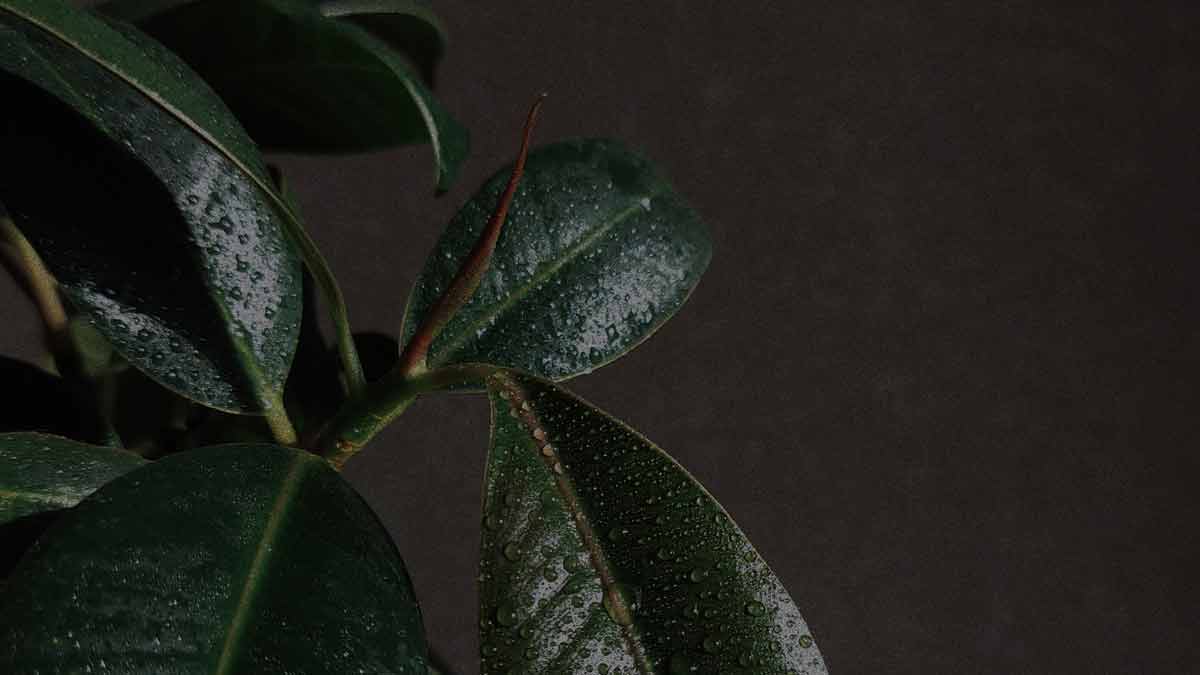Rubber plants (Ficus elastica) are a popular type of houseplant, and for a good reason. They’re easy to care for and can tolerate a wide range of growing conditions.
However, one of the most common problems with rubber plants is overwatering.
Overwatered rubber plants are susceptible to various problems, including pests, root rot, and fungal diseases.
In this article, we’ll discuss how to identify an overwatered rubber plant, treat it, and prevent it from happening in the future.
What Are the Risks of Overwatering a Rubber Plan?
While overwatering is a common problem with rubber plants, it’s important to note that too much water can be deadly to the plant.
When a rubber tree plant is overwatered, the roots cannot take in oxygen from the soil. This can lead to a variety of problems, including:
Fungal Growth
Overwatered conditions are ideal for fungal growth.
Fungi thrive in moist, dark environments and can quickly spread through the soil of an overwatered plant.
Fungal diseases can cause various problems for rubber fig plants, including leaf spot, root rot, and stem rot.
The most common fungal diseases that affect rubber plants are anthracnose, crown rot, and sooty mold.
Root Rot
Root rot is a common problem with overwatered plants.
The roots of the plant become waterlogged and begin to decompose. This can lead to various problems, including stunted growth, yellowing leaves, and eventually death.
Rubber plant root rot is a severe problem and can be challenging to treat.
Bacterial Problems
If you overwater your rubber tree plant, it can lead to bacterial problems.
Bacteria are another type of organism that can thrive in overwatered conditions.
The bacteria can attack the plant’s roots and stem, causing them to rot.
Bacteria infect rubber plants through wounds in the roots or stem.
Bacterial blight and crown gall are the most common bacterial diseases affecting rubber plants.
Pest Infestation
Overwatered plants are also more susceptible to pest infestations.
Pests, such as aphids, scale insects, and mealybugs, are attracted to the moisture on the leaves of overwatered plants.
Not only can pests cause damage to the plant itself, but they can also spread diseases.
How Does Overwatering a Rubber Plan Occur?
Overwatering is a common problem with rubber plants, but it’s often unintentional.
There are a few different ways that overwatering can occur:
1. Watering Too Often
One of the most common reasons for overwatering is simply watering the plant too often.
Rubber plants are drought-tolerant and only need to be watered every one to two weeks.
If you water your rubber plant more often than that, it can lead to overwatering.
2. Using the Wrong Soil
Another common cause of overwatering is using the wrong type of soil.
Rubber plants need well-draining soil to avoid overwatering.
Soil that doesn’t drain well can hold onto too much water and lead to overwatered conditions.
Using the wrong potting mix is one of the most common reasons for overwatering.
3. Using a Pot with No Drainage Hole
If you’re using a pot without a drainage hole, it can lead to overwatering.
When there’s no drainage hole, the water has nowhere to go and can quickly build up in the soil.
This can lead to waterlogged conditions and overwatering.
4. Using the Wrong Size Pot
Another common cause of overwatering is using a pot that’s too small for the plant.
If the pot is too small, it won’t be able to hold enough water to support the plant.
This can lead to the roots being exposed to air and the plant becoming overwatered.
5. Not Checking the Soil
One of the most important things you can do to avoid overwatering is to check the soil before watering.
Rubber plants need well-draining soil, so check that the soil is dry before watering.
You can stick your finger in the soil to your first knuckle to check the moisture level.
If the soil is still wet, it’s best to wait until it dries out before watering again.
6. Watering With Hard Water
If you’re using hard water to water your rubber plant, it can lead to overwatering.
Hard water contains high levels of minerals, such as calcium and magnesium.
These minerals can build up in the soil and prevent the roots from absorbing moisture.
This can lead to the plant becoming overwatered even if you’re not overwatering it.
How To Identify If Your Rubber Plan Is Overwatered?
Rubber plants are generally very easy to care for and tolerant of various conditions. However, like all plants, they can be overwatered.
Identifying the signs of overwatering in a rubber plant is essential, so you can take steps to treat and prevent it.
Signs of an Overwatered Rubber Plant
Overwatered rubber plants will display specific symptoms that can help you to identify the problem.
The most common signs of overwatering are:
The Soil is Soggy or Muddy
If you stick your finger into the soil and it comes out wet or muddy, this is a sure sign that the plant is overwatered.
When the rubber plant cannot absorb the water, it will sit in the soil and make it soggy.
This can lead to the roots rotting, eventually killing the plant.
The Leaves are Wilting
Another common sign of overwatering is wilting leaves.
When a plant is overwatered, the roots cannot absorb water quickly enough.
This causes the rubber plant leaves to wilt as they lack moisture.
The Leaves are Turning Yellow or Brown
Yellowing or browning leaves is another common sign of overwatering.
The roots cannot absorb the water and nutrients they need.
The rubber plant leaves will begin to turn yellow or brown as they start to die.
The Leaves are Drooping
Drooping leaves is another common sign of overwatering.
When the plant doesn’t have enough water, the leaves will droop down to conserve moisture.
If the rubber plant leaves are drooping, it’s a good idea to check the soil to see if it’s too wet.
The Stem is Soft or Squishy
If the plant’s stem is soft or squishy, this is a sure sign of overwatering.
When the plant doesn’t have enough water, the stem will start to rot.
This can kill the plant, so taking action as soon as possible is essential.
Mold is Growing on the Soil
Mold is another common sign of overwatering.
When the soil is too wet, it can start to grow mold.
Mold thrives in damp, dark conditions and can quickly kill a plant.
If you see mold growing in the soil, it’s a good idea to check the moisture level.
How To Save an Overwatered Rubber Plant
If you think your rubber plant is overwatered, there are a few things you can do to save it.
The most important thing is to take action as soon as possible.
The longer the plant stays overwatered, the more likely it is to die.
1. Check the Soil
The first step is to check the soil.
If the soil is wet or soggy, the plant is likely overwatered.
You can stick your finger into the soil to check the moisture level. If the soil is wet, it’s best to wait until it dries out before watering again.
2. Let the Plant Dry Out
If the plant is overwatered, you must let the soil dry before watering again.
This can be tricky, as you don’t want to let the plant get too dry.
The best way to do this is to wait until the top inch of the soil is dry before watering again.
You can also use a moisture meter to check the soil.
3. Prune the Dead Leaves
Some leaves will likely be wilted, yellow, or brown if the plant is overwatered.
These leaves are already dead and won’t recover.
It’s best to prune them off to help the plant focus its energy on the healthy leaves.
4. Repot the Plant
If the plant is overwatered, it’s a good idea to repot it.
This will help to improve the drainage and allow the roots to dry out.
Using a well-draining potting mix and a pot with holes in the bottom is best.
5. Remove Affected Roots
If the roots are overwatered, they may be rotted or dead.
It’s essential to remove any affected roots before replanting.
Otherwise, the plant will continue to struggle.
To remove the roots, gently loosen them from the soil with your fingers. If they’re rotted, they’ll fall away quickly.
Be sure to dispose of the affected roots, so they don’t contaminate the rest of the plant.
6. Cut Back on Fertilizer
Don’t fertilize the plant until it has recovered from overwatering.
Fertilizing an overwatered plant can further stress it and make it more difficult to recover.
After the plant has recovered, you can start fertilizing again.
Fertilize once a month during the growing season.
7. Place the Plant in a Bright, Airy Spot
After overwatering, it’s essential to place the plant in a bright, airy spot.
This will help it to dry out and prevent further overwatering.
Place the plant in a spot where it will get plenty of bright indirect light but won’t be exposed to direct sunlight.
You may also want to increase the airflow around the plant by opening a window or using a fan.
8. Water Properly
Once the plant has recovered from overwatering, water it properly.
Water when the top inch of soil is dry.
Be careful not to overwater again.
If you’re not sure how much to water, it’s best to err on the side of too little.
It’s better to underwater a rubber plant than overwater it.
How To Prevent Overwatering a Rubber Plant
Prevention is always better than cure; the same goes for overwatering your rubber plant.
Here are a few tips that can help you prevent overwatering your plant:
- Water your plant only when the topsoil is dry to the touch. Use your finger or a wooden skewer to test the soil before watering.
- Allow the water to drain freely after watering, and never leave the plant sitting in water.
- Water your plant early in the morning or later in the evening so that the plant has time to absorb the water before the heat of the day.
- If you use a pot with drainage holes, empty the drip tray after each watering.
- If possible, use rainwater or distilled water for your plants, as it contains fewer chemicals than tap water.
- Be mindful of the climate and weather conditions. If it is particularly hot and dry, your plant will need more water than usual. However, if it is cooler or wetter than expected, you will need to water your plant less.
- Make sure your pot has good drainage. If the pot does not have proper drainage, the plant’s roots will start to rot, and the plant will eventually die.
- Amend the potting soil with perlite, sand, or grit to improve drainage.
- If you are growing your rubber plant in a terrarium or closed jar, open it for a few hours every week to allow the air to circulate and prevent water vapor buildup.
- Inspect your plant regularly for signs of overwatering, such as wilting, yellowing leaves, or mushy stems. Take action immediately if you see any of these signs.
If you follow these tips, you should be able to prevent overwatering your rubber plant.
Final Thoughts
Growing a rubber plant is a relatively easy task. However, overwatering is a common mistake that can lead to several problems.
Catching overwatering early is essential to save your plant.
Check your plant regularly and pay close attention to the leaves.
If you notice any signs of overwatering, take action immediately.
With the proper care, your rubber plant will thrive.







